(HOT) UPSC Current Affairs 2025 PDF
NEW! The Gist (NOV-2025) | E-BOOKS
(GIST OF SCIENCE REPORTER) Chandrayaan-3
(GIST OF SCIENCE REPORTER) Chandrayaan-3
(August-2023)
Chandrayaan-3
Chandrayaan-3 is a follow-on mission to Chandrayaan-2 to demonstrate end-to-end capability in safe landing and roving on the lunar surface. LVM III M4 (4 indicates 4th operational flight of the vehicle) was used for lifting off Chandrayaan-3, which placed the integrated spacecraft in an elliptic Parking Orbit (ePO) of size ~170 x 36,500 km.
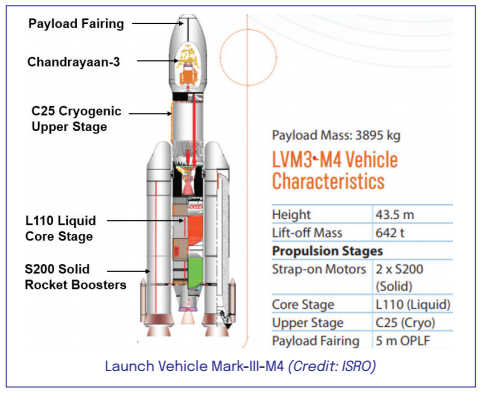
As Chandrayaan-3 is a repeat mission its cost is relatively less. The total cost of the Chandrayaan-3 mission is over ₹615 Crores. In comparison, the Chandrayaan-2 mission cost was ₹978 Crores. This includes the launch cost of around Rs -375 Crores.
The Chandrayaan-3 mission has three main objectives:
1. The primary objective is going to be a safe, soft and precise landing of the Lander on the lunar South Pole.
2. To demonstrate Rover operations on the Moon surface, and
3. To carry out on-site scientific experiments on the lunar soil.
Chandrayaan-2 Vs Chandrayaan-3
Chandrayaan-3 is built upon the “lessons learned” from the unsuccessful landing of Chandrayaan-2. It is equipped with more advanced systems which have undergone increased simulation and testing.
The following are some of the major modifications in Chandrayaan-3 over Chandrayaan-2:
1. As the orbiter module of Chandrayaan-2 is still functional it is replaced with a propulsion module with a single payload. In comparison, the Chandrayaan-2’s orbiter carried nine science payloads. This simplifies the work of the Propulsion Module to focus on its crucial role in bringing the Lander Module to the Moon.
2. Reinforcement in Landing Leg Mechanism to withstand higher landing touchdown velocity from 2 m/s to 3 m/s.
3. Fuel margins on the Lander are increased to handle unplanned mission profiles, if any.
4. Laser Doppler Velocimeter (LDV) is added to provide crucial information about the terrain. LDV will measure the velocity and distance of the Lander from the lunar surface during descent.
5. Software upgrade to handle failures such as engine and thrust disruptions, and sensor failures.
6. Central engine from the Lander is removed for better operational efficiency.
7. Solar panel area on Lander is increased for higher power generation.
8. Increased battery capacity to mitigate weaker solar power generation.
9. Three additional TTC antennas are incorporated to provide higher data rate and improved redundancy.
10. Two Lander hazard Detection and Avoidance Cameras (LhDAC) and Processing Algorithm are used compared to one in Chandrayaan-2. Two additional cameras are placed on the rear side and the field of view for hazard detection and avoidance increased.
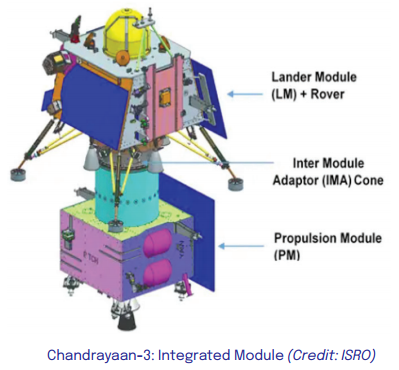
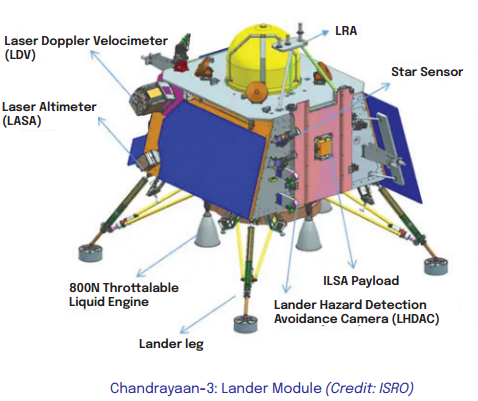
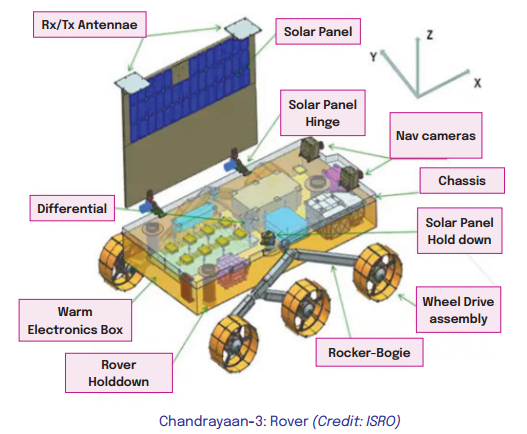
The Spacecraft: Chandrayaan-3
Chandrayaan-3 consists of two Modules — Propulsion and Lander (Lander + Rover). After landing, the Rover will roll out to the Moon surface. The major specifications of the spacecraft are as follows:
• Mission Life: Propulsion Module-3-6 months, Lander Module-One lunar day (~14 earth days).
• Landing Site (Prime): 4 km x 2.4 km; 69.367621°S, 32.348126°e.
• Mass: Propulsion Module – 2148 kg; Lander Module – 1752 kg including Rover of 26 kg, Total 3900 kg.
• Power generation: Propulsion Module: 758 W, Lander Module: 738 W, Winter Solstice with Bias, Rover: 50 W.
• Communication: Propulsion Module communicates with Indian Deep Space Network (IDSN). Whereas Lander Module communicates with both IDSN and Rover.
Chandrayaan-2 Orbiter was also planned as a back-up link. Rover can communicate only with Lander.
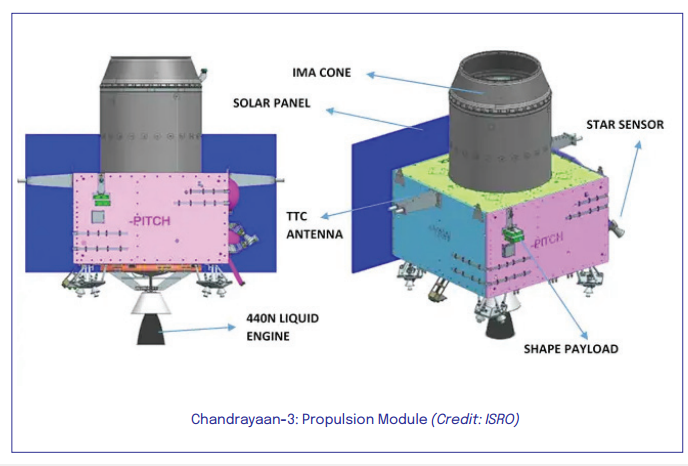

CLICK HERE TO DOWNLOAD FULL PDF
CLICK HERE TO DOWNLOAD UPSC E-BOOKS
Study Material for UPSC General Studies Pre Cum Mains
Get The Gist 1 Year Subscription Online
Click Here to Download More Free Sample Material
<<Go Back To Main Page
Courtesy: Science Reporter



